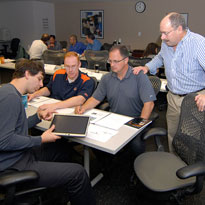Unified Communications in Public Safety
- Course:Unified Communications in Public Safety
- Course ID:UNIFIED Duration:2-3 days Where: Your Office (7+ Persons)
- Download Course Description (PDF)
Available as a private, customized course for your group at your offices or ours and in some cases as a WebLive(TM) class.
Course Outline
Introduction: Multiple Views of Unified Communications
- Microsoft View
- Cisco View
- IBM View
- Nortel, Avaya and Alcatel-Lucent View
- Service Provider View
- UC vs Unified Messaging
Web 1.0 to Web 2.0
- The O’Reilly Factor
- Shifting Paradigms
Multimedia, Internet, Communications, Entertainment (MICE)
- MICE Overview
- Life beyond the Triple Play
- Infrastructure, QoS, and QoE
- Service Ubiquity
- Broadband Wireless
- Standards
- Platforms and Mobility
- Role of IMS
Unified Communications Architectures in Depth
- Microsoft
- Solution Integration
- Network Infrastructure
- Security
- Mobility
- Network Management
- Third-party Applications
- Solution Integration
- Cisco
- Solution Integration
- Network Infrastructure
- Security
- Mobility
- Network Management
- Third-party Applications
- Solution Integration
- Avaya
- Solution Integration
- Network Infrastructure
- Security
- Mobility
- Network Management
- Third-party Applications
- Solution Integration
- ShoreTel
- Solution Integration
- Network Infrastructure
- Security
- Mobility
- Network Management
- Third-party Applications
- Solution Integration
- Networx Universal UC Services
- AT&T
- UC Service Descriptions
- Availability
- QoS/QoE
- Security
- Service Level Agreements
- Qwest
- UC Service Descriptions
- Availability
- QoS/QoE
- Security
- Service Level Agreements
- Verizon
- UC Service Descriptions
- Availability
- QoS/QoE
- Security
- Service Level Agreements
- AT&T
Inside UC Part 1: Sessions
- Session Initiation Protocol (SIP)
- SIP Protocol
- SIP Call Flows
- SIP Testing
- SIP Security
- SIP SIMPLE
- Session Description Protocol (SDP)
- SDP Format
- SDP: Data Sessions
- SDP: Voice Sessions/VoIP
- SDP: Video Sessions
- RSVP
- Call Admission Control
- Quality of Service (QoS)
- Quality of Experience (QoE)
- Location Tracking
- Presence Applications/SIP Presence Engine (SPE)
- User Location
- Wireless
- Wireline
- Cisco Emergency Responder
- Session Border Controller (SBC)
Individual Lab Exercise and Group Debrief: SIP, SDP and RSVP Internals and Testing
Inside UC Part 2: Data
- HTTP/sHTTP
- HTML/XML
- FTP/TFTP
Inside UC Part 3: Voice
- SIP Voice
- SCCP/Cisco Skinny
- H.323
- MGCP
Inside UC Part 4: Video
- Videoconferencing Rooms
- Unified IP Phones
- Unified Video Advantage
- Multipoint/Multimedia Control Unit
- H.320 / H.323
- SCCP
- SIP
Inside UC Part 5: Rich Media Conferencing
- Integration
- SMTP
- Jabber
- Outlook
- Web Conferencing
- TelePresence
Inside UC Part 6: Security
- Privacy and Security
- Certificates and Certificate Authorities
- Encryption
- Key Management, PKI, pKI
- SIP Proxy/Secure Authentication
- HTTP Digest Authentication
- Secure Real Time Protocol
- Cisco Remote Party ID (RPID)
Pulling it All Together
- UC and MICE
Individual Discovery Lab Exercise and Group Debrief: Unified Communications
Conclusion
Course in a Nutshell
This intermediate-to-advanced course is intended to prepare an engineering audience for the sea change that is now occurring in communications. It provides the key knowledge and skills required to deal with the Unified Communications protocols, architectures, analysis and system testing, and to understand where Unified Communications — as defined by multiple vendors — fits into the overall public safety, law enforcement and homeland security capability, productivity and application set. Upon course completion, you will know everything needed to understand and deal with the next generation of applications as well as the network infrastructure required to support them. Highlights include:
- Brief high level overview of UC and Web 2.0 industry landscape
- Architectural overview of multiple vendors’ Unified Communications architectures
- Protocol Workshop based upon a discovery learning approach
- Emphasis on productivity and impact of UC on operations environment
- Focus on Quality of Service (QoS) and Quality of Experience (QoE) issues
- Security, Certificate Authorities, Encryption and Key Management
Customize It!
Customize this course to your group’s requirements at little-to-no added cost. We can teach distinct versions of this course tailored for audiences such as network planners, equipment/application designers, and less technical audiences such as managers, executives, business planners, sales/marketing specialists, and operations and support personnel. The specific topics discussed in the course, as well as the depth of treatment for each, can also be tailored to your need.
Aimed At
Technical personnel in public safety, law enforcement, and homeland security arenas who need to undertake a comprehensive study of Unified Communications, from the high-level industry and architectural perspective to the low level protocols and internals.
Prerequisites
A working knowledge of the IP suite, data, voice and video protocols, along with a basic understanding of the principles of Quality of Service/Experience (QoS and QoE) will help fully appreciate the material covered in this course. Those who lack some or all of these prerequisites will still benefit from the course, though they may not be able to finish the lab work during class.
- CALEA: Technologies and Compliance
- Comm. Technologies for Public Safety, Law Enforcement, Homeland Security
- Security, Privacy & Info. Integrity for Managers & Policy Makers
- WiFi Wireless LAN Security
- IP, Location & Geo-location for Public Safety
- IP Security v2
- IP Security v3
- Network Security
- SIP Security
- SIP Workshop
- VoIP Security
- Voice Communications for 911 Personnel
- VoIP for 911 Personnel
- 911 for IP Professionals

